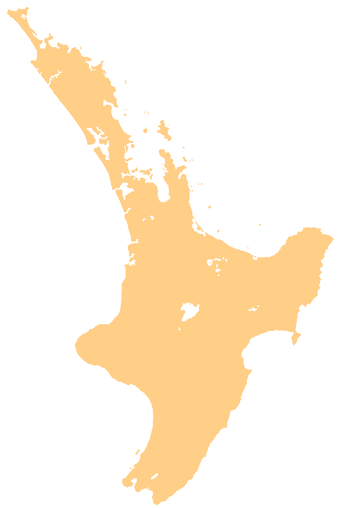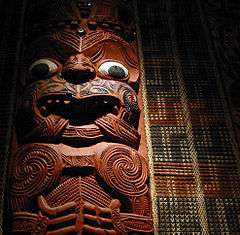Thames, New Zealand
| Thames Hotereni (Māori) | |
|---|---|
 Thames | |
| Coordinates: 37°8′18″S 175°32′15″E / 37.13833°S 175.53750°E | |
| Country | New Zealand |
| Region | Waikato |
| District | Thames-Coromandel District |
| Population (June 2016)[1] | |
| • Total | 7,140 |
| Postcode(s) | 3508 |
Thames ![]() i/ˈtɛmz/ is a town at the southwestern end of the Coromandel Peninsula in New Zealand's North Island. It is located on the Firth of Thames close to the mouth of the Waihou River. The town is the seat of the Thames-Coromandel District Council. The Māori iwi are Ngāti Maru, who are descendants of Marutuahu's son Te Ngako. Ngāti Maru is part of the Ngati Marutuahu confederation of tribes or better known as Hauraki Iwi.
i/ˈtɛmz/ is a town at the southwestern end of the Coromandel Peninsula in New Zealand's North Island. It is located on the Firth of Thames close to the mouth of the Waihou River. The town is the seat of the Thames-Coromandel District Council. The Māori iwi are Ngāti Maru, who are descendants of Marutuahu's son Te Ngako. Ngāti Maru is part of the Ngati Marutuahu confederation of tribes or better known as Hauraki Iwi.
Many people migrated to Thames at its peak, and it was soon the second-largest city in New Zealand (the largest being Dunedin then Auckland). However, as the gold began to diminish, so did the number of inhabitants, and although Thames never shrank, it has never grown much either. It is still the biggest town on the Coromandel. The population in the 2006 census was 6,756, an increase of 51 since 2001.[2] Until 2016, a historical oak tree that was planted by Governor George Grey stood on the corner of Grey and Rolleston streets.[3]
History

Origin
Thames was formed from two historic towns, Grahamstown and Shortland, of which many original buildings still stand. Shortland was to the south of Thames and was founded on 27 July 1867 when James Mackay, civil commissioner for the Hauraki District, concluded an agreement with local Māori. The land was rented for mining purposes for the sum of £5,000 per year, a colossal sum in the mid 19th century. This agreement secured the rights to local mineral deposits leading to the proclamation of the Thames Goldfield on 1 August. The leasing of the land for such a huge income was a source of great envy by other Maori iwi and hapu.[4]
Grahamstown was founded the following year at the northern end of present Thames, approximately one mile from Shortland. The two towns merged in 1874 after it emerged the heart of the Goldfield was in Grahamstown. Shortland waned in importance until the turn of the century when the Hauraki Plains were developed for farming and the Shortland railway station was opened.
Gold rush
The town was initially built during a gold rush, with the first major discovery of gold being made on 10 August 1867 by William Hunt, in the Kuranui Stream at the north end of Thames.[5] The subsequent mine produced more than 102,353oz bullion and was known as the Shotover. The era from 1868 to 1871 were the bonanza years for the town with gold production topping one million pounds sterling at its peak. Official figures for production of the Thames Mines recorded a yield of 2,327,619oz bullion with the value at $845 million. The three richest fields were the Manukau / Golden Crown / Caledonian mines but many others yielded near equivalent amounts. Towards the end of the 19th century Thames was the largest centre of population in New Zealand with 18,000 inhabitants and well over 100 hotels and three theatres in 1868. For a while it was thought it would replace Auckland as the major town in the area. Thames also benefited from a period of extensive Kauri logging in the surrounding ranges around the same time.
Meeting house
The land involved in goldmining in Thames was Māori-owned; important parts of the goldfield were owned by the Ngāti Maru rangatira (chief) Rapana Maunganoa and the Taipari family. In 1878, when Wiremu Hōterene Taipari married a woman of the Ngāti Awa tribe of Whakatāne, Ngāti Awa carvers arrived at Thames and built a meeting house at Pārāwai. It is incorrectly said to have been a wedding gift for the couple, when actually Wiremu's father had paid money for another whare (meeting house), which was sold to the governor general at the time. When Wiremu's father returned to collect the whare the Ngati Awa chief apologised and said he would have another one built which would signify the marriage between Wiremu Taipari and his daughter. The house, named Hotunui[6] in honour of an important Ngāti Maru ancestor, now stands in the Auckland War Memorial Museum.
Recent history
The Thames branch railway connecting the town with Hamilton was opened in 1898 and was closed in 1991 and the tracks taken up. It now provides part of the course for the Hauraki Rail Trail. The Carters - Kopu sawmill, 9 km south of Thames, closed in 2008 with the loss of 145 jobs.[7][8] In 2012, mayor of Thames-Coromandel called NZTA safety procedures into question when a sink hole on State Highway 25 north of Thames, opened above an old mine shaft.[9]
Local government
The area was initially controlled by the Auckland Provincial Council. In late 1871, a public meeting in Grahamstown resolved:[10]
That in the opinion of the meeting it is desirable that a Municipal Corporation should be established for the Thames.
This resulted in the forming of a Thames Municipality Committee in early 1872. The Borough of Thames was gazetted in November 1873. The first Borough Council was elected in March 1874. As was practice at the time, the councillors voted one from their midst to be the mayor. William Davies was the only person proposed and voted into the role unanimously in April 1874.[10]
During the 1870s, Governor George Grey represented Thames in the New Zealand Parliament.[3]
In total, there were 24 Mayors of Thames Borough.[11] In 1975, Thames Borough amalgamated with Coromandel County, out of which Thames-Coromandel District arose.[10] Hence, the role was succeeded by that of the Mayor of Thames-Coromandel.
Business and Economy

Thames Hospital is the oldest still operating in New Zealand, having been built in the 1860s. The Māori owned land was donated by the Ngāti Maru rangatira Rapana Maunganoa. A new clinical centre and other improvements were completed in 2008, and a new maternity facility opened on 5 September 2011.[12] The Thames Jockey Club was one of the earliest to be established in New Zealand.[13]
The Thames Aerodrome is 3 km south of the town. Regular flights to Auckland are operated by Great Barrier Airlines. A major employer is the Toyota New Zealand plant, which assembled CKD cars until 1998, and now refurbishes imported used cars. Another is the precision engineering works and foundry of A & G Price, established 1868, who built 123 steam locomotives for New Zealand Railways Department. The Brian Boru Hotel, built in 1868, is the oldest Irish pub in New Zealand.[14] Goldfields Shopping Centre is a major shopping mall of Thames.[15] Many residents work in tourism and locally owned businesses servicing the local farming community.
Education
Thames High School is a secondary (years 9–13) school with a decile rating of 6 and a roll of 563.[16] The school was established in 1880 and is the second oldest secondary school in the Auckland Province.[17] Moanataiari School, Parawai and Thames South are full primary (years 1–8) schools with decile ratings of 5, 6 and 3 and rolls of 178, 225 and 160, respectively.[18][19][20] St Francis School is a full primary (years 1–8) school with a decile rating of 7 and a roll of 86.[21] It is a state integrated Catholic school.[22]
All these schools are coeducational.
A former local institution of learning was the Thames School of Mines.
Notable people from Thames
- Kylie Bax – model and actress
- Sonny Parker – Welsh international rugby union player
- Lloyd Stephenson – Hockey player
- Bruce Purchase – British actor
- Air Chief Marshal Sir Keith Park – WW2 Air Commander and AOC 11 Group during Battle of Britain (July – October 1940)
- Sir Graham Liggins - medical/obstetrical researcher
References
- ↑ "Subnational Population Estimates: At 30 June 2016 (provisional)". Statistics New Zealand. 21 October 2016. Retrieved 21 October 2016. For urban areas, "Subnational population estimates (UA, AU), by age and sex, at 30 June 1996, 2001, 2006-16 (2017 boundary)". Statistics New Zealand. 21 October 2016. Retrieved 21 October 2016.
- ↑ The population is the sum of the statistical areas of Moanataiari (Quickstats about Moanataiari) and Parawai (Quickstats about Parawai)
- 1 2 KELSEY WILKIE (November 2016). "High winds cause havoc in Thames". Stuff.co.nz.
- ↑ Kennedy, David (1876). Kennedy's Colonial Travel. Cambridge, Mass.: Cambridge University Press Digital Republished 2011. ISBN 978-1-108-03991-8.
- ↑ "Our Heritage". Retrieved 2013-02-10.
- ↑ "Hotunui, Whare Runanga". Auckland War Memorial Museum. Retrieved 2015-11-19.
- ↑ "Kopu mill to close, 145 jobs to be lost". The New Zealand Herald. 6 May 2008.
- ↑ Gay, Edward (14 October 2008). "Small town 'devastated' at mass job losses". The New Zealand Herald.
- ↑ Huge sink hole opened up on Thames highway
- 1 2 3 "Council History". Thames-Coromandel District Council. Retrieved 18 May 2012.
- ↑ "Mayors and Councillors of Thames". The Treasury. Retrieved 18 May 2012.
- ↑ "New primary birthing unit opens in Thames". Retrieved 24 November 2011.
- ↑ Johnny Williams (1987). Racing For Gold. Williams Publishers. ISBN 0-473-00441-0. Retrieved 25 February 2013.
- ↑ Ghost Hunt: True New Zealand Ghost Stories ISBN 0-7900-1012-7
- ↑ GOLDFIELDS SHOPPING CENTRE
- ↑ Te Kete Ipurangi schools database: Thames High School
- ↑ "About us". Thames High School.
- ↑ Te Kete Ipurangi schools database: Moanataiari School
- ↑ Te Kete Ipurangi schools database: Parawai School
- ↑ Te Kete Ipurangi schools database: Thames South School
- ↑ Te Kete Ipurangi schools database: St Francis School
- ↑ "Thames Parish". Coromandel Catholic Parishes.
External links
| Wikimedia Commons has media related to Thames, New Zealand. |
 Thames travel guide from Wikivoyage
Thames travel guide from Wikivoyage- Thames Information
- "Thames in Cyclopaedia of New Zealand (1902)". NZETC. 1 December 2015.
- 1871-74 tram route